Asset Management and Deepwater Horizon Disaster of 2010
VerifiedAdded on 2022/11/11
|11
|1391
|52
Presentation
AI Summary
This presentation covers the concept of asset management, its importance in the engineering context, and the case of Deepwater Horizon disaster of 2010. It also includes a strategic asset management plan covering the entire asset life cycle.
Contribute Materials
Your contribution can guide someone’s learning journey. Share your
documents today.

Asset management
Deepwater Horizon disaster of 2010
Deepwater Horizon disaster of 2010
Secure Best Marks with AI Grader
Need help grading? Try our AI Grader for instant feedback on your assignments.
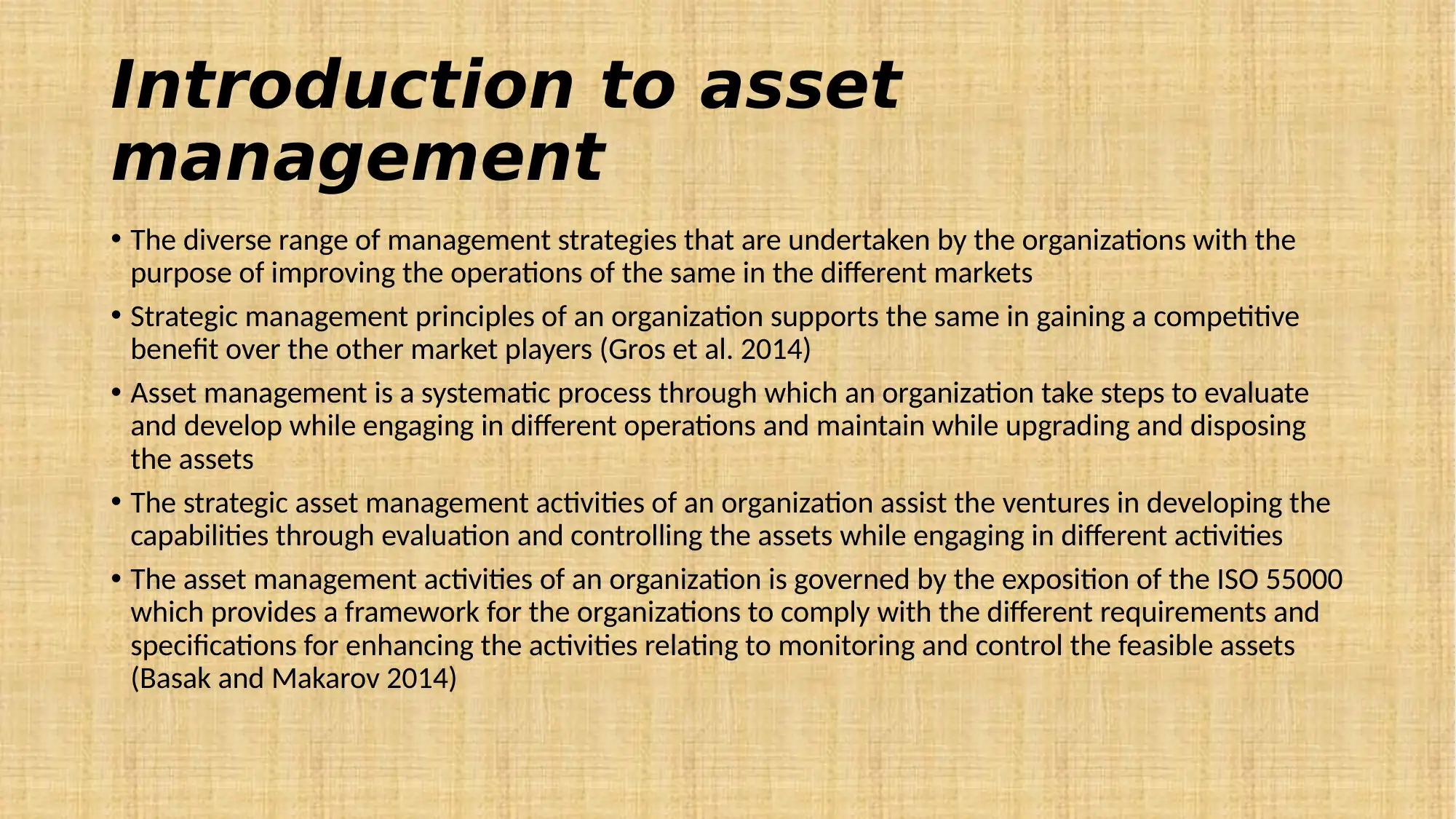
Introduction to asset
management
• The diverse range of management strategies that are undertaken by the organizations with the
purpose of improving the operations of the same in the different markets
• Strategic management principles of an organization supports the same in gaining a competitive
benefit over the other market players (Gros et al. 2014)
• Asset management is a systematic process through which an organization take steps to evaluate
and develop while engaging in different operations and maintain while upgrading and disposing
the assets
• The strategic asset management activities of an organization assist the ventures in developing the
capabilities through evaluation and controlling the assets while engaging in different activities
• The asset management activities of an organization is governed by the exposition of the ISO 55000
which provides a framework for the organizations to comply with the different requirements and
specifications for enhancing the activities relating to monitoring and control the feasible assets
(Basak and Makarov 2014)
management
• The diverse range of management strategies that are undertaken by the organizations with the
purpose of improving the operations of the same in the different markets
• Strategic management principles of an organization supports the same in gaining a competitive
benefit over the other market players (Gros et al. 2014)
• Asset management is a systematic process through which an organization take steps to evaluate
and develop while engaging in different operations and maintain while upgrading and disposing
the assets
• The strategic asset management activities of an organization assist the ventures in developing the
capabilities through evaluation and controlling the assets while engaging in different activities
• The asset management activities of an organization is governed by the exposition of the ISO 55000
which provides a framework for the organizations to comply with the different requirements and
specifications for enhancing the activities relating to monitoring and control the feasible assets
(Basak and Makarov 2014)
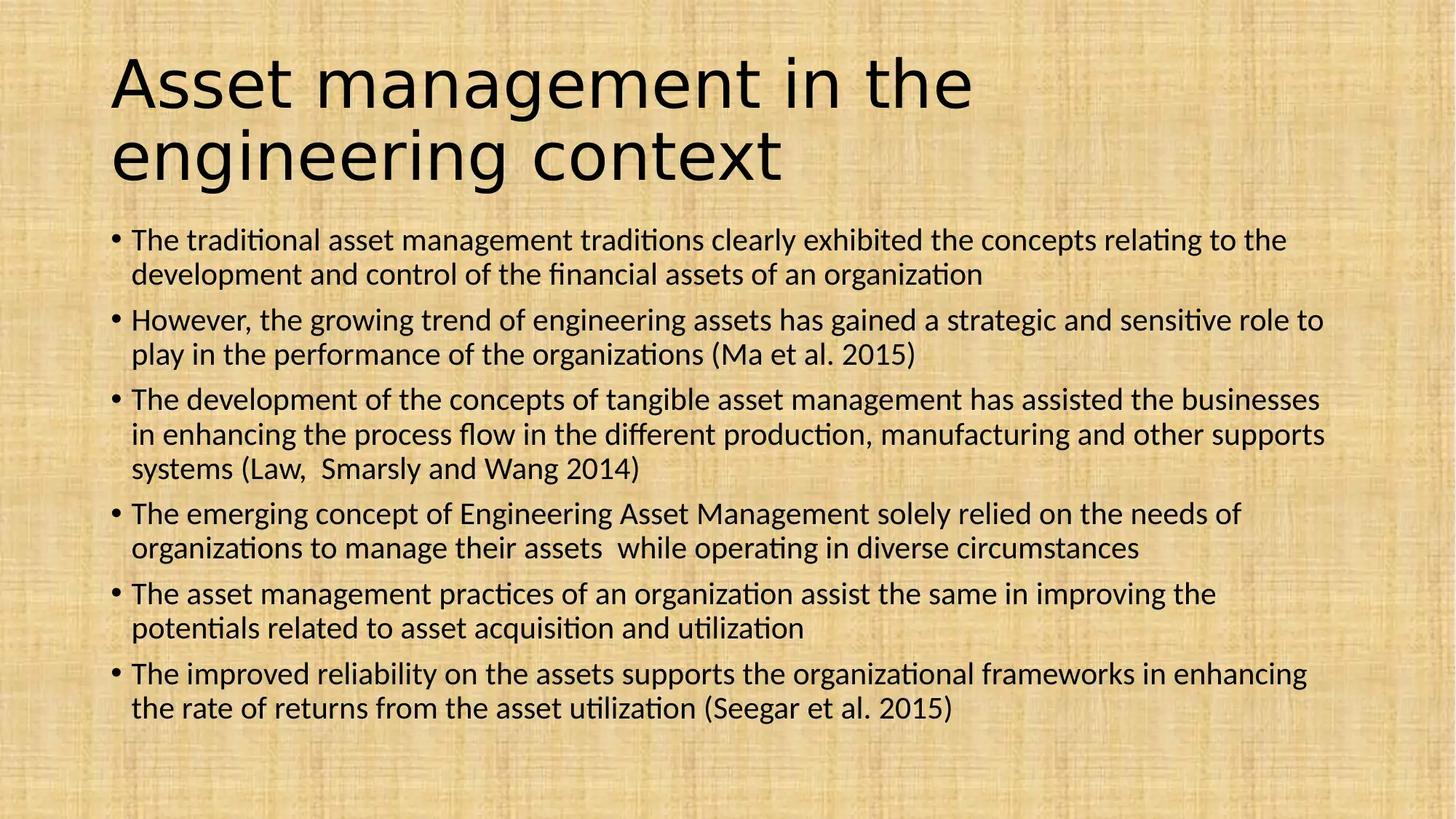
Asset management in the
engineering context
• The traditional asset management traditions clearly exhibited the concepts relating to the
development and control of the financial assets of an organization
• However, the growing trend of engineering assets has gained a strategic and sensitive role to
play in the performance of the organizations (Ma et al. 2015)
• The development of the concepts of tangible asset management has assisted the businesses
in enhancing the process flow in the different production, manufacturing and other supports
systems (Law, Smarsly and Wang 2014)
• The emerging concept of Engineering Asset Management solely relied on the needs of
organizations to manage their assets while operating in diverse circumstances
• The asset management practices of an organization assist the same in improving the
potentials related to asset acquisition and utilization
• The improved reliability on the assets supports the organizational frameworks in enhancing
the rate of returns from the asset utilization (Seegar et al. 2015)
engineering context
• The traditional asset management traditions clearly exhibited the concepts relating to the
development and control of the financial assets of an organization
• However, the growing trend of engineering assets has gained a strategic and sensitive role to
play in the performance of the organizations (Ma et al. 2015)
• The development of the concepts of tangible asset management has assisted the businesses
in enhancing the process flow in the different production, manufacturing and other supports
systems (Law, Smarsly and Wang 2014)
• The emerging concept of Engineering Asset Management solely relied on the needs of
organizations to manage their assets while operating in diverse circumstances
• The asset management practices of an organization assist the same in improving the
potentials related to asset acquisition and utilization
• The improved reliability on the assets supports the organizational frameworks in enhancing
the rate of returns from the asset utilization (Seegar et al. 2015)
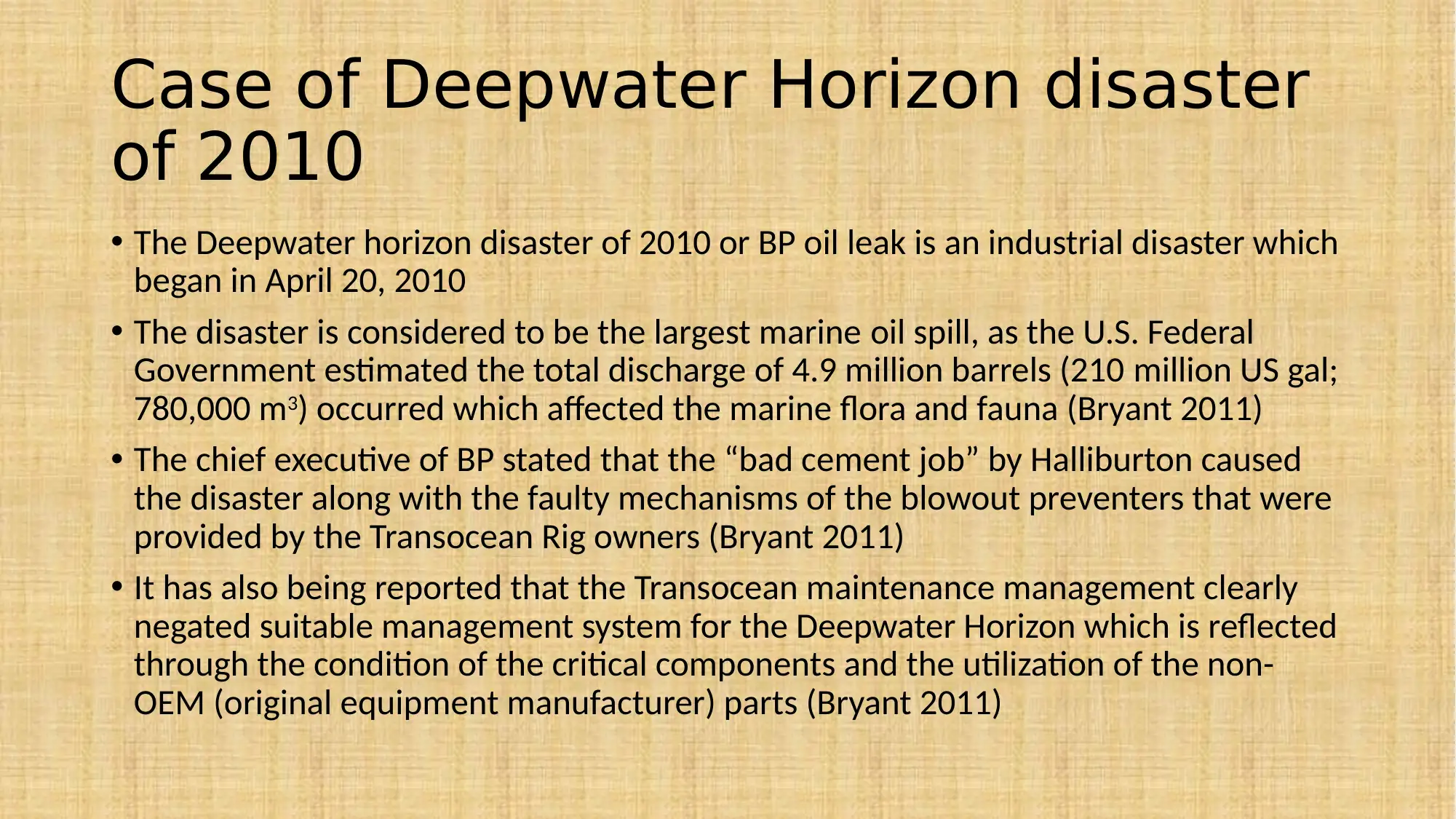
Case of Deepwater Horizon disaster
of 2010
• The Deepwater horizon disaster of 2010 or BP oil leak is an industrial disaster which
began in April 20, 2010
• The disaster is considered to be the largest marine oil spill, as the U.S. Federal
Government estimated the total discharge of 4.9 million barrels (210 million US gal;
780,000 m3) occurred which affected the marine flora and fauna (Bryant 2011)
• The chief executive of BP stated that the “bad cement job” by Halliburton caused
the disaster along with the faulty mechanisms of the blowout preventers that were
provided by the Transocean Rig owners (Bryant 2011)
• It has also being reported that the Transocean maintenance management clearly
negated suitable management system for the Deepwater Horizon which is reflected
through the condition of the critical components and the utilization of the non-
OEM (original equipment manufacturer) parts (Bryant 2011)
of 2010
• The Deepwater horizon disaster of 2010 or BP oil leak is an industrial disaster which
began in April 20, 2010
• The disaster is considered to be the largest marine oil spill, as the U.S. Federal
Government estimated the total discharge of 4.9 million barrels (210 million US gal;
780,000 m3) occurred which affected the marine flora and fauna (Bryant 2011)
• The chief executive of BP stated that the “bad cement job” by Halliburton caused
the disaster along with the faulty mechanisms of the blowout preventers that were
provided by the Transocean Rig owners (Bryant 2011)
• It has also being reported that the Transocean maintenance management clearly
negated suitable management system for the Deepwater Horizon which is reflected
through the condition of the critical components and the utilization of the non-
OEM (original equipment manufacturer) parts (Bryant 2011)
Secure Best Marks with AI Grader
Need help grading? Try our AI Grader for instant feedback on your assignments.
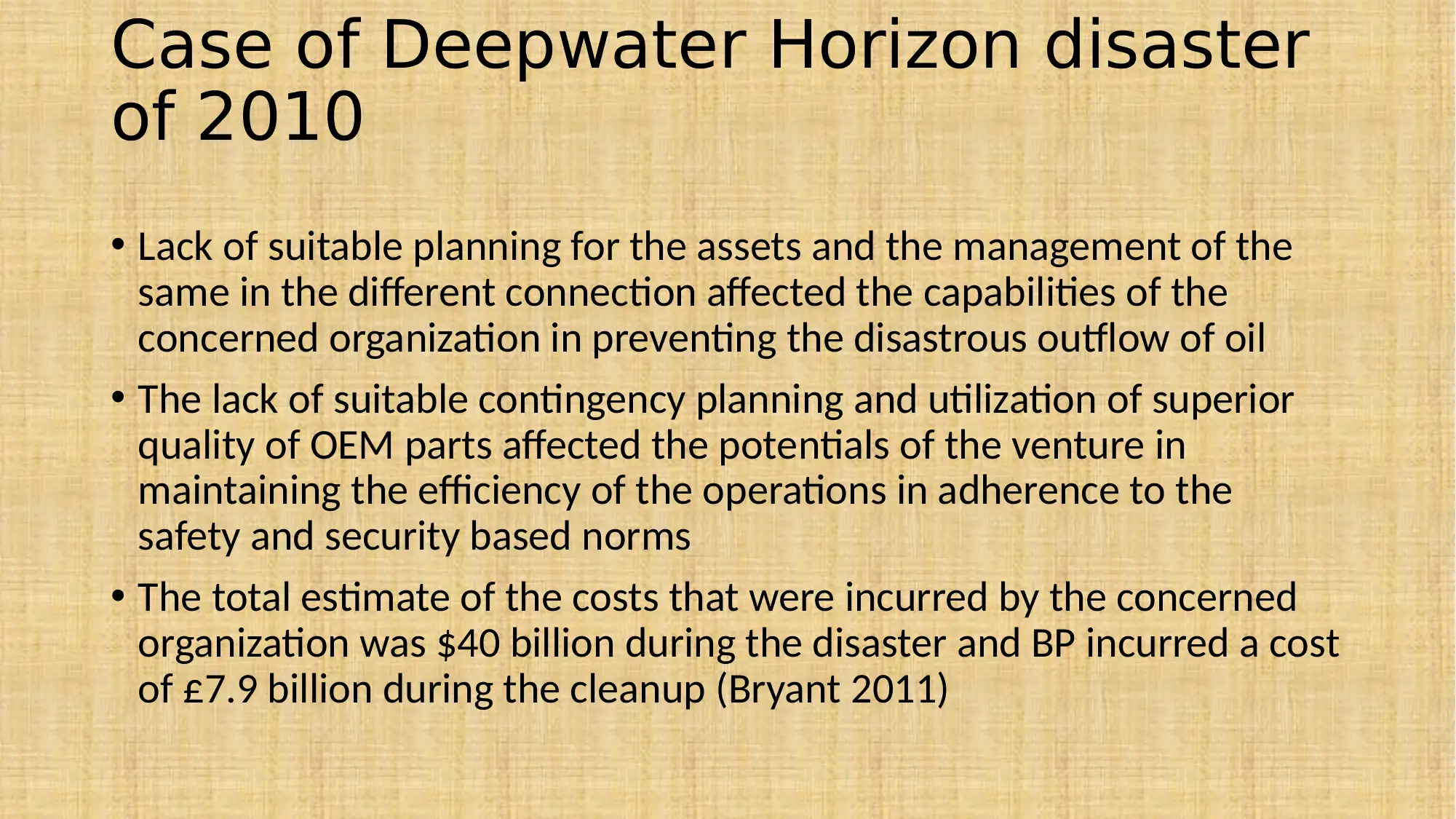
Case of Deepwater Horizon disaster
of 2010
• Lack of suitable planning for the assets and the management of the
same in the different connection affected the capabilities of the
concerned organization in preventing the disastrous outflow of oil
• The lack of suitable contingency planning and utilization of superior
quality of OEM parts affected the potentials of the venture in
maintaining the efficiency of the operations in adherence to the
safety and security based norms
• The total estimate of the costs that were incurred by the concerned
organization was $40 billion during the disaster and BP incurred a cost
of £7.9 billion during the cleanup (Bryant 2011)
of 2010
• Lack of suitable planning for the assets and the management of the
same in the different connection affected the capabilities of the
concerned organization in preventing the disastrous outflow of oil
• The lack of suitable contingency planning and utilization of superior
quality of OEM parts affected the potentials of the venture in
maintaining the efficiency of the operations in adherence to the
safety and security based norms
• The total estimate of the costs that were incurred by the concerned
organization was $40 billion during the disaster and BP incurred a cost
of £7.9 billion during the cleanup (Bryant 2011)

Risk management
Risk Ref. No. Risk Category Risk Description Risk Cause Risk Consequences Impact Likelihood Rating
1 Finance
The disaster destroyed a
significant number of the
assets of the BP which in
turn is likely to put a
financial pressure on the
concerned enterprise
Inadequate management of
the assets
British Petroleum is likely to
lose a substantial amount of
its capital through the loss
of valuable assets because
of the disaster
4-Major 4-Likely High
2 Security
BP because of the complete
disregard of the regulations
or the stipulations related to
the management or the
maintenance of its assets
faced the disaster which in
turn had raised security
concerns regarding the
entire operations of the
entire enterprise
Ineffective asset
maintenance or
management practices
followed by BP
Brand image might be
compromised
5-Catastrophic 5-Almost Certain Extreme
3 Commercial
The disaster is likely to
raise doubts in the minds of
the customers regarding its
entire business operations
and this in turn can
substantially affect their
loyalty towards the entire
Lack of skilled personnel Brand image might be
compromised
4-Major 4-Likely High
Risk Ref. No. Risk Category Risk Description Risk Cause Risk Consequences Impact Likelihood Rating
1 Finance
The disaster destroyed a
significant number of the
assets of the BP which in
turn is likely to put a
financial pressure on the
concerned enterprise
Inadequate management of
the assets
British Petroleum is likely to
lose a substantial amount of
its capital through the loss
of valuable assets because
of the disaster
4-Major 4-Likely High
2 Security
BP because of the complete
disregard of the regulations
or the stipulations related to
the management or the
maintenance of its assets
faced the disaster which in
turn had raised security
concerns regarding the
entire operations of the
entire enterprise
Ineffective asset
maintenance or
management practices
followed by BP
Brand image might be
compromised
5-Catastrophic 5-Almost Certain Extreme
3 Commercial
The disaster is likely to
raise doubts in the minds of
the customers regarding its
entire business operations
and this in turn can
substantially affect their
loyalty towards the entire
Lack of skilled personnel Brand image might be
compromised
4-Major 4-Likely High
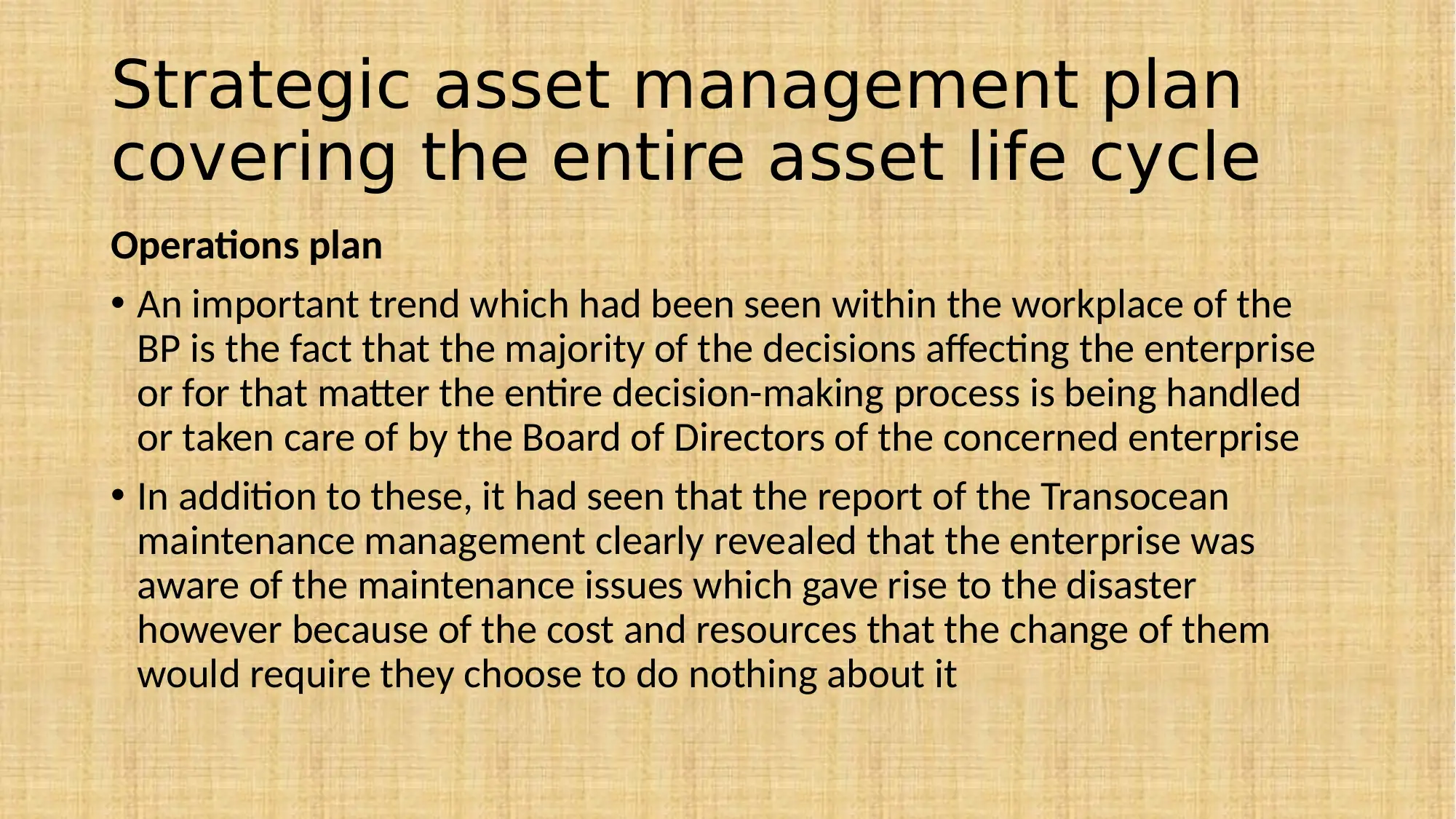
Strategic asset management plan
covering the entire asset life cycle
Operations plan
• An important trend which had been seen within the workplace of the
BP is the fact that the majority of the decisions affecting the enterprise
or for that matter the entire decision-making process is being handled
or taken care of by the Board of Directors of the concerned enterprise
• In addition to these, it had seen that the report of the Transocean
maintenance management clearly revealed that the enterprise was
aware of the maintenance issues which gave rise to the disaster
however because of the cost and resources that the change of them
would require they choose to do nothing about it
covering the entire asset life cycle
Operations plan
• An important trend which had been seen within the workplace of the
BP is the fact that the majority of the decisions affecting the enterprise
or for that matter the entire decision-making process is being handled
or taken care of by the Board of Directors of the concerned enterprise
• In addition to these, it had seen that the report of the Transocean
maintenance management clearly revealed that the enterprise was
aware of the maintenance issues which gave rise to the disaster
however because of the cost and resources that the change of them
would require they choose to do nothing about it
Paraphrase This Document
Need a fresh take? Get an instant paraphrase of this document with our AI Paraphraser

Strategic asset management plan
covering the entire asset life cycle
Equipment Maintenance Plans
• An important within the BP is the fact that the concerned enterprise is the
fact that the different equipment of the concerned enterprise, are being
used until and unless they do not break down and no maintenance processes
are being used to enhance the lifecycle of the equipment
Recapitalization Plans and Strategies
• the concerned enterprise can take the help of a reuse or recycle policy
through which it will reuse the parts of the damaged or faulty equipment
which are in working condition in other machines so as to reduce its
operations cost and also to reduce the damage to the environment or the
planet that it causes through its business activities
covering the entire asset life cycle
Equipment Maintenance Plans
• An important within the BP is the fact that the concerned enterprise is the
fact that the different equipment of the concerned enterprise, are being
used until and unless they do not break down and no maintenance processes
are being used to enhance the lifecycle of the equipment
Recapitalization Plans and Strategies
• the concerned enterprise can take the help of a reuse or recycle policy
through which it will reuse the parts of the damaged or faulty equipment
which are in working condition in other machines so as to reduce its
operations cost and also to reduce the damage to the environment or the
planet that it causes through its business activities
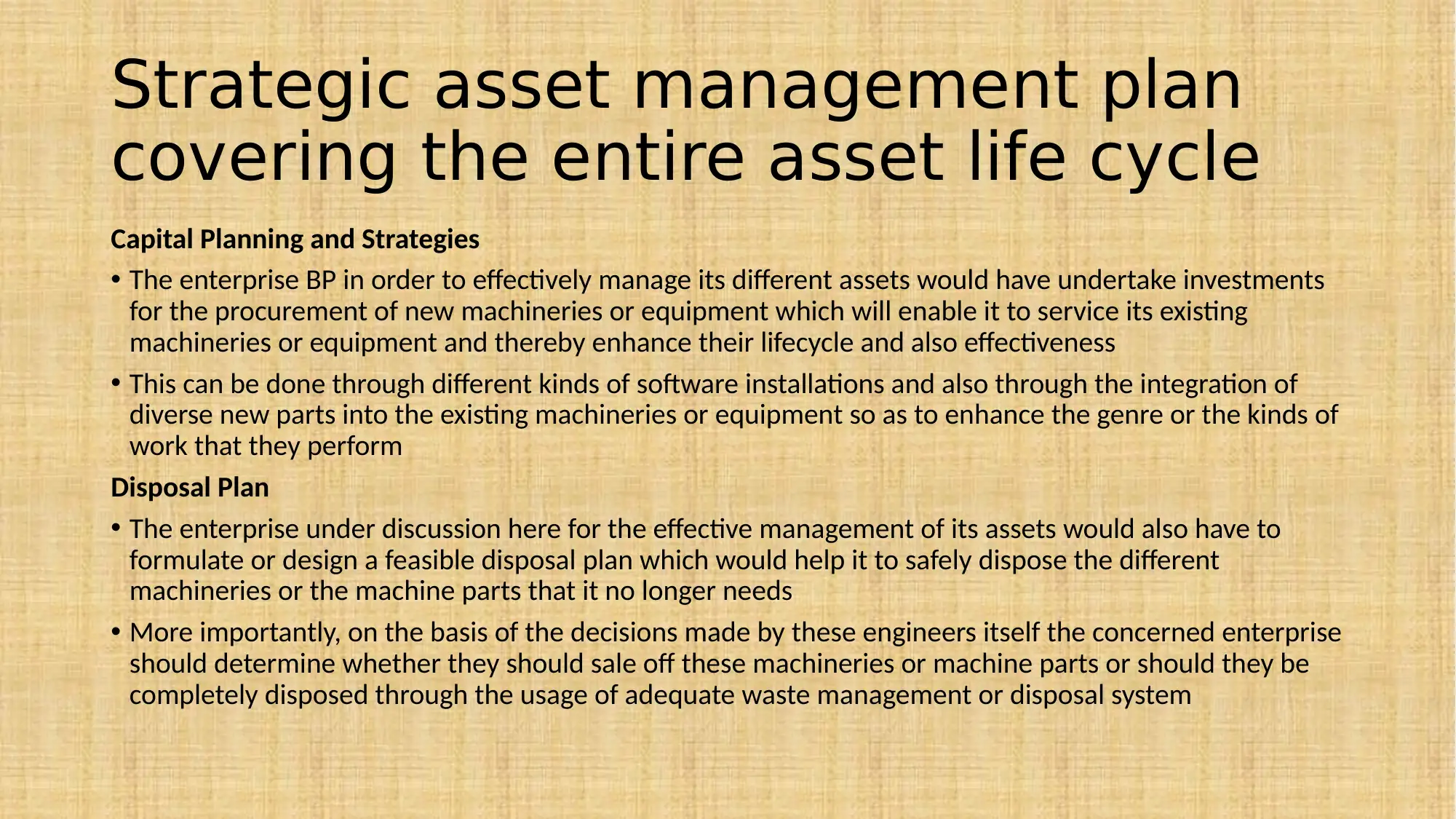
Strategic asset management plan
covering the entire asset life cycle
Capital Planning and Strategies
• The enterprise BP in order to effectively manage its different assets would have undertake investments
for the procurement of new machineries or equipment which will enable it to service its existing
machineries or equipment and thereby enhance their lifecycle and also effectiveness
• This can be done through different kinds of software installations and also through the integration of
diverse new parts into the existing machineries or equipment so as to enhance the genre or the kinds of
work that they perform
Disposal Plan
• The enterprise under discussion here for the effective management of its assets would also have to
formulate or design a feasible disposal plan which would help it to safely dispose the different
machineries or the machine parts that it no longer needs
• More importantly, on the basis of the decisions made by these engineers itself the concerned enterprise
should determine whether they should sale off these machineries or machine parts or should they be
completely disposed through the usage of adequate waste management or disposal system
covering the entire asset life cycle
Capital Planning and Strategies
• The enterprise BP in order to effectively manage its different assets would have undertake investments
for the procurement of new machineries or equipment which will enable it to service its existing
machineries or equipment and thereby enhance their lifecycle and also effectiveness
• This can be done through different kinds of software installations and also through the integration of
diverse new parts into the existing machineries or equipment so as to enhance the genre or the kinds of
work that they perform
Disposal Plan
• The enterprise under discussion here for the effective management of its assets would also have to
formulate or design a feasible disposal plan which would help it to safely dispose the different
machineries or the machine parts that it no longer needs
• More importantly, on the basis of the decisions made by these engineers itself the concerned enterprise
should determine whether they should sale off these machineries or machine parts or should they be
completely disposed through the usage of adequate waste management or disposal system
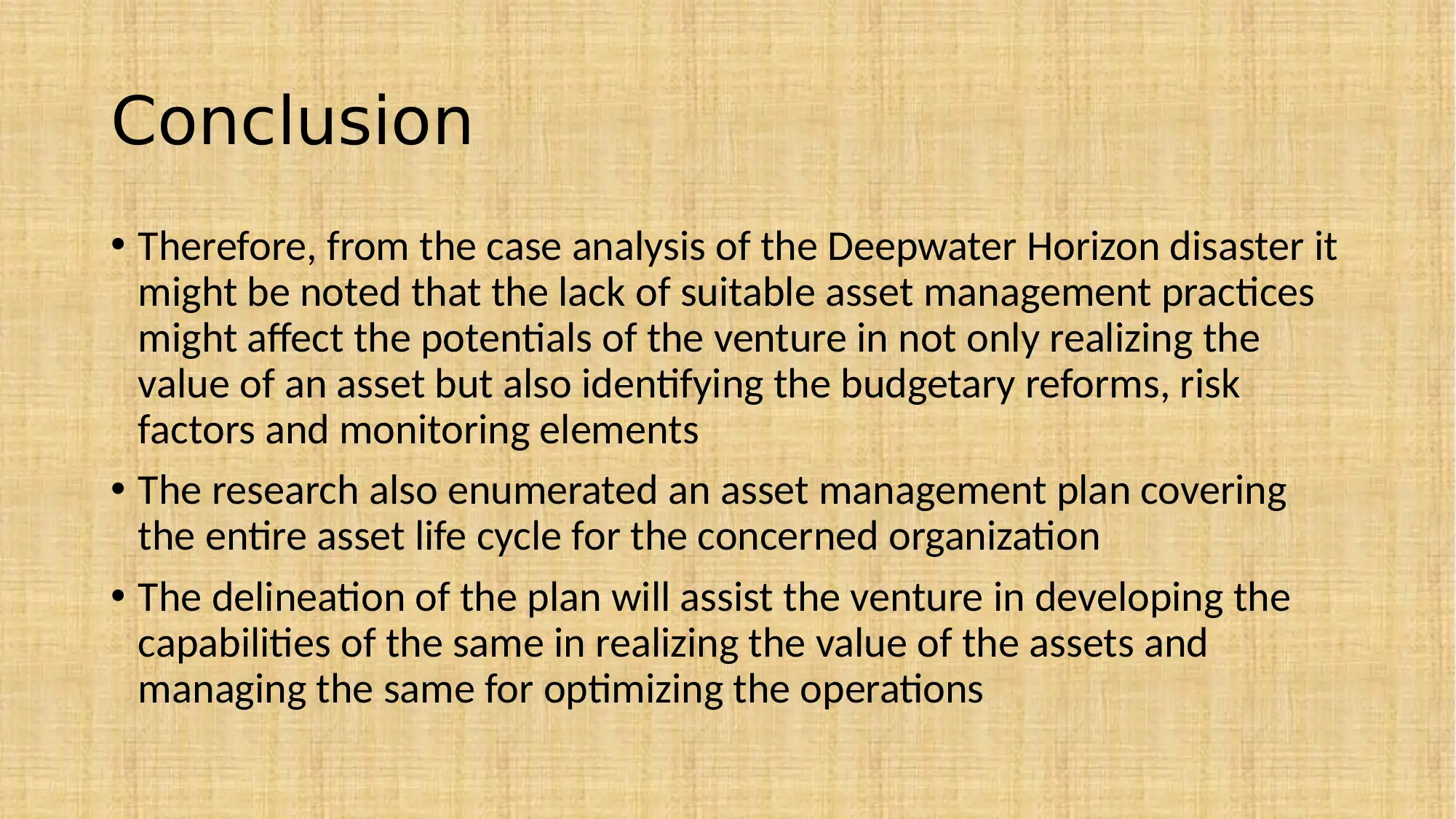
Conclusion
• Therefore, from the case analysis of the Deepwater Horizon disaster it
might be noted that the lack of suitable asset management practices
might affect the potentials of the venture in not only realizing the
value of an asset but also identifying the budgetary reforms, risk
factors and monitoring elements
• The research also enumerated an asset management plan covering
the entire asset life cycle for the concerned organization
• The delineation of the plan will assist the venture in developing the
capabilities of the same in realizing the value of the assets and
managing the same for optimizing the operations
• Therefore, from the case analysis of the Deepwater Horizon disaster it
might be noted that the lack of suitable asset management practices
might affect the potentials of the venture in not only realizing the
value of an asset but also identifying the budgetary reforms, risk
factors and monitoring elements
• The research also enumerated an asset management plan covering
the entire asset life cycle for the concerned organization
• The delineation of the plan will assist the venture in developing the
capabilities of the same in realizing the value of the assets and
managing the same for optimizing the operations
Secure Best Marks with AI Grader
Need help grading? Try our AI Grader for instant feedback on your assignments.

References
• Basak, S. and Makarov, D., 2014. Strategic asset allocation in money management. The Journal of Finance, 69(1),
pp.179-217.
• Bryant, B., 2011. Deepwater Horizon and the Gulf oil spill - the key questions answered. [online] the Guardian.
Available at: https://www.theguardian.com/environment/2011/apr/20/deepwater-horizon-key-questions-
answered [Accessed 23 May 2019].
• Gros, J., Reddy, C.M., Aeppli, C., Nelson, R.K., Carmichael, C.A. and Arey, J.S., 2014. Resolving biodegradation
patterns of persistent saturated hydrocarbons in weathered oil samples from the Deepwater Horizon
disaster. Environmental science & technology, 48(3), pp.1628-1637.
• Law, K.H., Smarsly, K. and Wang, Y., 2014. Sensor data management technologies for infrastructure asset
management. In Sensor Technologies for Civil Infrastructures(pp. 3-32). Woodhead Publishing.
• Ma, H., Saha, T.K., Ekanayake, C. and Martin, D., 2015. Smart transformer for smart grid—intelligent framework
and techniques for power transformer asset management. IEEE Transactions on Smart Grid, 6(2), pp.1026-1034.
• Seegar, W.S., Yates, M.A., Doney, G.E., Jenny, J.P., Seegar, T.C., Perkins, C. and Giovanni, M., 2015. Migrating
Tundra Peregrine Falcons accumulate polycyclic aromatic hydrocarbons along Gulf of Mexico following
Deepwater Horizon oil spill. Ecotoxicology, 24(5), pp.1102-1111.
• Basak, S. and Makarov, D., 2014. Strategic asset allocation in money management. The Journal of Finance, 69(1),
pp.179-217.
• Bryant, B., 2011. Deepwater Horizon and the Gulf oil spill - the key questions answered. [online] the Guardian.
Available at: https://www.theguardian.com/environment/2011/apr/20/deepwater-horizon-key-questions-
answered [Accessed 23 May 2019].
• Gros, J., Reddy, C.M., Aeppli, C., Nelson, R.K., Carmichael, C.A. and Arey, J.S., 2014. Resolving biodegradation
patterns of persistent saturated hydrocarbons in weathered oil samples from the Deepwater Horizon
disaster. Environmental science & technology, 48(3), pp.1628-1637.
• Law, K.H., Smarsly, K. and Wang, Y., 2014. Sensor data management technologies for infrastructure asset
management. In Sensor Technologies for Civil Infrastructures(pp. 3-32). Woodhead Publishing.
• Ma, H., Saha, T.K., Ekanayake, C. and Martin, D., 2015. Smart transformer for smart grid—intelligent framework
and techniques for power transformer asset management. IEEE Transactions on Smart Grid, 6(2), pp.1026-1034.
• Seegar, W.S., Yates, M.A., Doney, G.E., Jenny, J.P., Seegar, T.C., Perkins, C. and Giovanni, M., 2015. Migrating
Tundra Peregrine Falcons accumulate polycyclic aromatic hydrocarbons along Gulf of Mexico following
Deepwater Horizon oil spill. Ecotoxicology, 24(5), pp.1102-1111.
1 out of 11
Related Documents
Your All-in-One AI-Powered Toolkit for Academic Success.
+13062052269
info@desklib.com
Available 24*7 on WhatsApp / Email
![[object Object]](/_next/static/media/star-bottom.7253800d.svg)
Unlock your academic potential
© 2024 | Zucol Services PVT LTD | All rights reserved.





